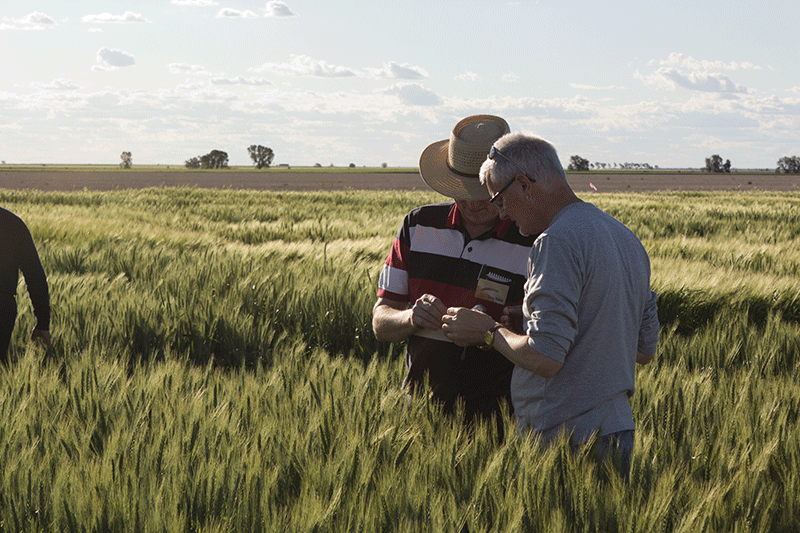International Wheat Conference
LESSONS FROM ABROAD
IN SEPTEMBER 2015 I had the chance to join over 600 delegates from 66 countries at the ninth International Wheat Conference (IWC) in Sydney, Australia. The conference provided an opportunity to engage with leading wheat researchers from around the world, and to learn about wheat research within a country that has a unique research investment system and has recently invested more, on a per acre basis, into wheat research than any other country in the world1. Wheat was first grown in Australia in January 1788 on the current site of the Royal Botanical Gardens in Sydney, and since that first growing season wheat has become established as a staple in Australian agriculture. Australia is currently a significant player on the global stage in fifth position when it comes to wheat exports (2014 data) and its level of wheat research investments has been second-to-none.

One of the roles of the research team at Grain Farmers of Ontario is to continually develop our research investment strategy to bring Ontario’s grain farmers the best value from their research dollars in both the short and long term. Major international scientific conferences, like the IWC, provide an opportunity to benchmark where Ontario stands regarding our crop research and to identify research gaps and synergies that can be further developed within and beyond the province of Ontario.
During his keynote address, Dr. Sanjaya Rajaram, the 2014 World Food Prize Laureate, noted that the global demand for wheat by 2030 is expected to be 30 per cent higher than the current demand.
With the current average global wheat yield around 3.2 tonnes/ha, global productivity would need to increase by 1.6% per year to address a demand for wheat that is estimated to reach one billion tonnes by 2030. Average global gains in wheat from genetics have been about one per cent per year from 1996 – 2010. Ontario winter wheat yield gains have been on par with this, on average, over the last 30 years. However, on-farm winter wheat yield increases have stagnated over the past decade for various reasons, not the least of which has included several years of challenging weather conditions.
BREEDING
So what contributes to continued yield gains? Hans-Joachim Braun, director of the International Maize and Wheat Improvement Center (CIMMYT) Global Wheat Program, noted that, “about 50 per cent of breeding gains are due to exchanges of germplasm.”
The inclusion of new germplasm into breeding programs gives breeders more building blocks to use in their pursuit of the core breeding targets for wheat: resistance to wheat diseases and pests, tolerance to environmental stresses, improved grain quality, and higher yields. A few programs worldwide have gone so far as to re-create and examine new crosses of the original two ancestral wheat and grass species that were crossed in the Middle East about 10,000 years ago to create the domesticated wheat we have today. This pursuit can make even more genetic variation available to incorporate into new wheat varieties, but this process can be very slow and it can take many years to restore the standard agronomic characteristics farmers take for granted in current wheat varieties.
However, without these laborious upstream efforts to bring new genetic variation into wheat, the genetic building blocks for developing continually-improved wheat varieties will be unable to sustain the continual improvements to wheat varieties that are needed in the long term.
AGRONOMICS
In addition to the breeding and pre-breeding efforts, agronomic research should not be overlooked. Broadly speaking, agronomic research is often estimated to contribute to about half of the yield gains seen in wheat. While new improved varieties are relatively simple to incorporate into a farming operation, the modification of agronomic practices on a farm is often a more complicated and longer term process. However, once there is a clear path for a farmer to update agronomic practices to match what current research conclusions are recommending, the effects can be substantial.
One example from the IWC was a new research and communication initiative launched in several sub-Saharan African countries (particularly focused in Ethiopia, Sudan, and Nigeria) which has resulted in yields up to six tonnes/ha within regions more familiar with a two tonnes/ha yield. As farmers in these regions have learned about and implemented improved crop management systems, these yield increases have become very common and it can start to change the dynamics of the global wheat supply.
COLLABORATION
What does this mean for Grain Farmers of Ontario? The world of crop research is global, with regional adaptations needed on the ground. As we continue to work with increasingly scarce research funds and an increasingly sophisticated understanding of grain crops, the development of strategic collaborations becomes all the more important. There are opportunities to collaborate on wheat research topics at the provincial, national, and international scale to address priorities of interest to Ontario’s grain farmers, such as identifying underlying mechanisms that contribute to higher yields and the development of Fusarium head blight and rust resistance (it was noted at the IWC that 97 per cent of the world’s wheat crop is grown in areas susceptible to at least one wheat rust).
The involvement of Grain Farmers of Ontario in the 2013-2018 Growing Forward 2 National Wheat Improvement Program, which is focused on wheat breeding and genetics and is led by the Western Grains Research Foundation, is one example of an already national integration of research, and these research networks continue to expand. For now, we’ll continue to build these networks and we look forward to seeing what the world of wheat will look like when Saskatoon, Saskatchewan hosts the next IWC in 2019 here on Canadian soil.
Josh Cowan is the manager of research and innovation for Grain Farmers of Ontario.
1 (“Our future world relies on wheat research today” by Gio Braidotti, Ground Cover, Issue 95, Nov-Dec 2011, Grains Research & Development Corporation, http://www.grdc. com.au/Media-Centre/Ground-Cover/Ground- Cover-Issue-95-November-December-2011/ Our-future-world-relies-on-wheat-research-today). •

















